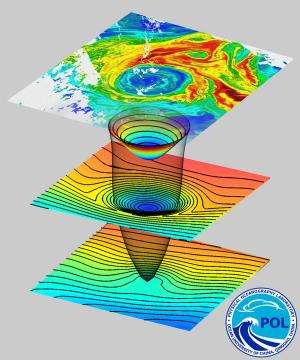June 27, 2014 report
Mesoscale eddies found to move far more ocean water than previously thought

(Phys.org) —A trio of researchers, two from the Ocean University of China, and a third from the University of Hawaii, has found that mesoscale eddies—swirling masses of water that travel westward in the subtropics—appear to carry far more water with them than scientists have realized. In their paper published in the journal Science, Zhengguang Zhang, Wei Wang and Bo Qiu discuss the study they undertook of the water vortices using altimetry and data from ARGO submersibles to measure the size of the eddies and to track their movements over time.
Mesoscale eddies are spinning masses of water (50 to 300 miles in diameter) that fall between observable eddies such as those created by ships and very large ones known as gyres. Scientists have known about them for quite some time, but till now, very little was known about their size and movements. To find out more, the researchers analyzed data from both satellites and submersible probes.
Satellites operated by NASA have radar onboard that is sensitive enough to measure the altitude of the Earth's surface to within inches—and that includes the oceans. Mesoscale eddies can be detected due to depressions formed as they spin. The researchers collected a decade's worth of such data allowing them to create an animated map that shows the movement of multiple mesoscale eddies across the oceans—always moving east to west, and generally in subtropical regions, where background flows are weak. The team also studied data from the more than 3,000 ARGO submersibles that have been deployed to various depths in the world's oceans—that allowed them to create 3D renderings of the eddies as they exist beneath the surface.
Putting all the data together, the team was able to see that such eddies can live for months, or even years—it also allowed for calculating how much water they carry, approximately 30-40 Sv (1 Sv = 106 m3 s−1), which is roughly equivalent to the amount of ocean water moved by wind or due to temperature variations. The amount is far more than most oceanographers had imagined, and stirs questions regarding the role they may play as the oceans grow warmer.
The researchers plan to continue their research, focusing most specifically on how tightly the eddies hold on to material they capture, such as floating debris, pollutants, heat and carbon.
More information: Oceanic Mass Transport by Mesoscale Eddies, Science DOI: 10.1126/science.1252418
ABSTRACT
Oceanic transports of heat, salt, and fresh water, dissolved CO2 and other tracers regulate global climate change and distribution of natural marine resources. While the time-mean ocean circulation transports fluid as a conveyor belt, fluid parcels can also be trapped and transported discretely by migrating mesoscale eddies. By combining available satellite altimetry and Argo profiling float data, we show that the eddy-induced zonal mass transport can reach a total meridionally integrated value up to 30-40 Sv (1 Sv = 106 m3 s−1), and it occurs mainly in subtropical regions where the background flows are weak. This transport is comparable in magnitude with that of the large-scale, wind- and thermohaline-driven circulation.
Journal information: Science
© 2014 Phys.org



















